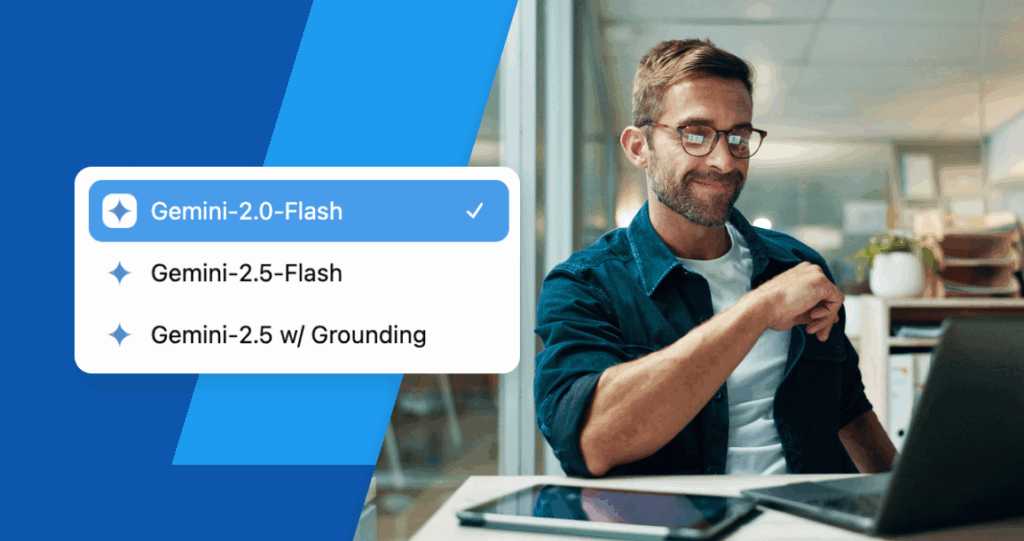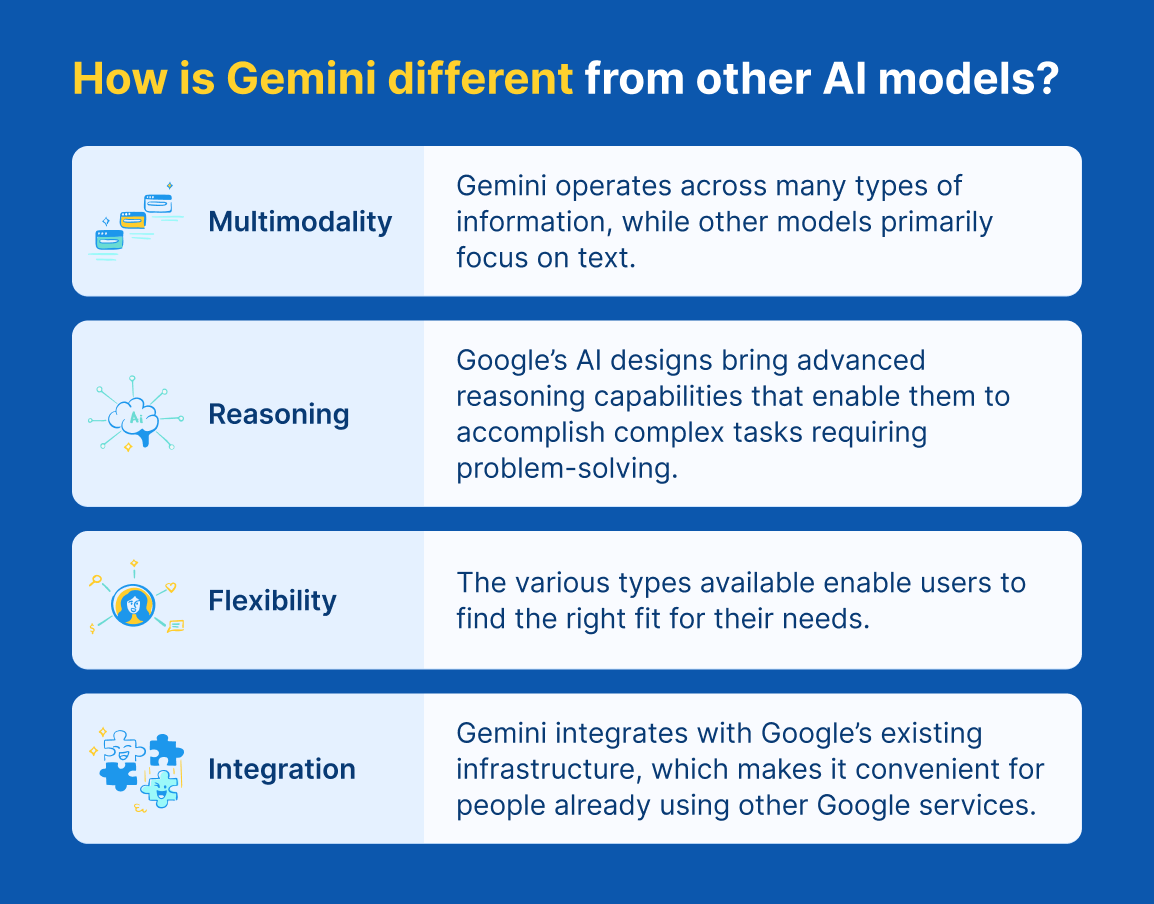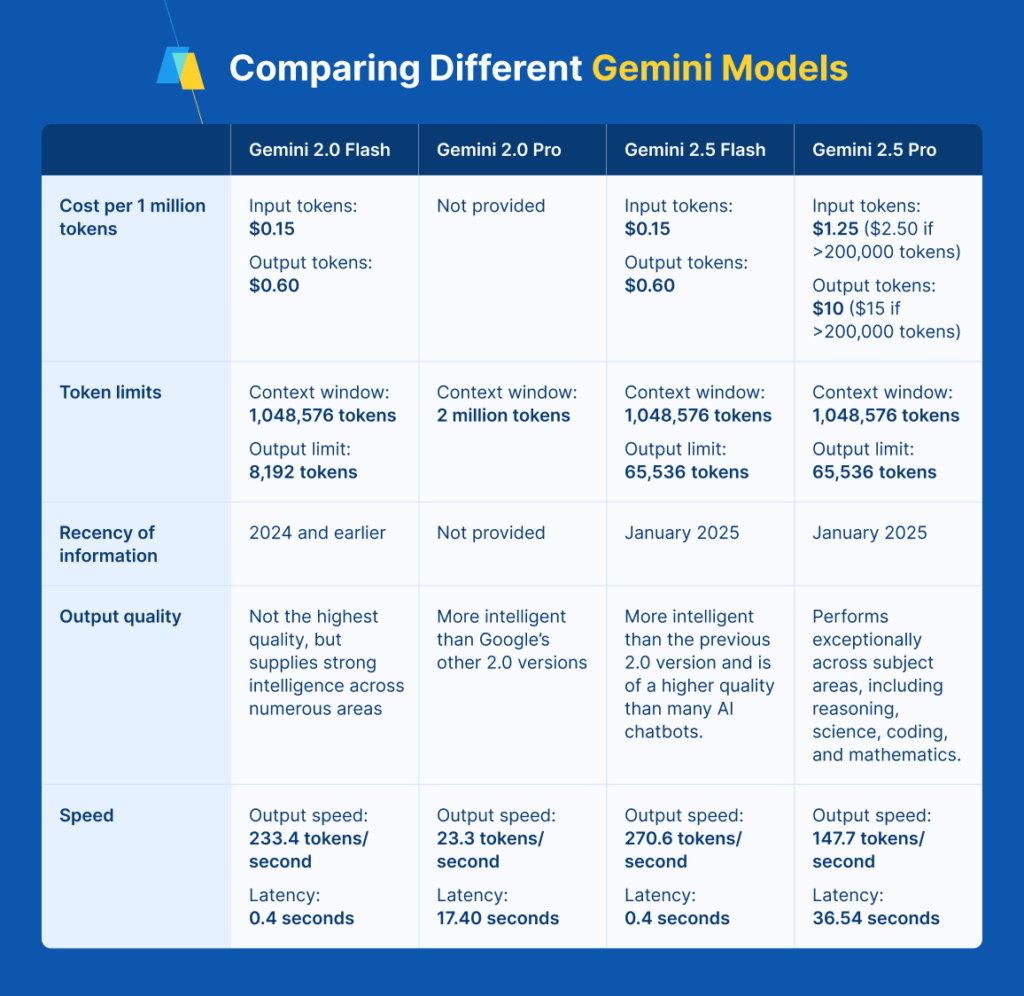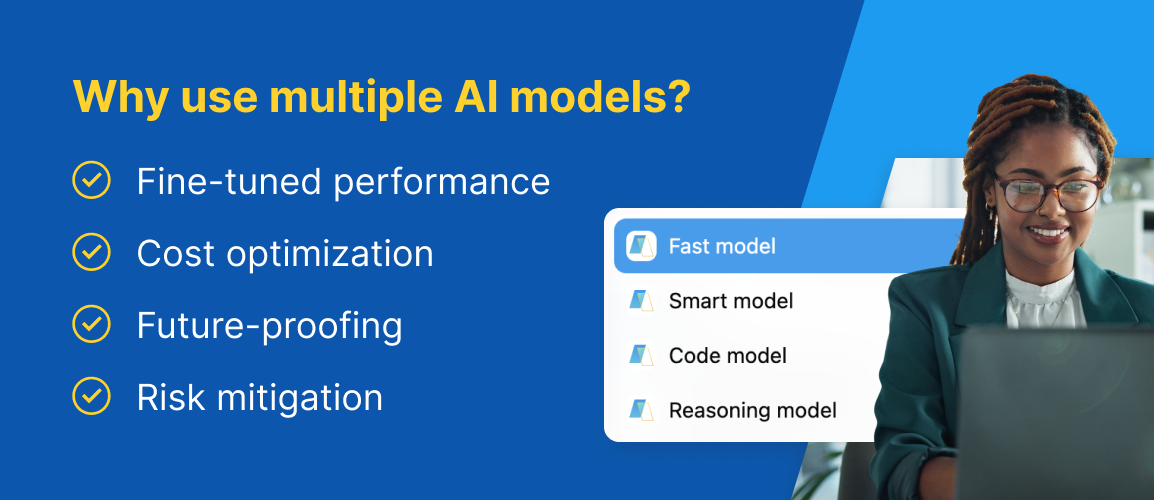Gemini is a series of AI models created by Google. They include features like natural language processing, machine learning, and personalized user experiences. These systems integrate with and enhance Google’s services, including search.
Users can employ these models in various applications beyond search, as well. They stand out from other AI products due to their multimodality across text, image, video, audio, and code.

How is Gemini different from other AI models?
Here are a few ways Gemini stands out:
- Multimodality: As previously mentioned, Gemini operates across many types of information, while other models primarily focus on text.
- Reasoning: Google’s AI designs bring advanced reasoning capabilities that enable them to accomplish complex tasks requiring problem-solving.
- Flexibility: The various types available enable users to find the right fit for their needs, whether they want a fast, simple answer or an in-depth analysis.
- Integration: Gemini integrates with Google’s existing infrastructure, which makes it convenient for people already using other Google services. It also benefits from access to extensive information and resources.
While Gemini has impressive capabilities, users may still need to watch out for issues like encoded biases and hallucinations, which any AI technology brings occasionally.

Major model comparison
When you choose Google’s AI, you benefit from a selection of options that fit how you plan to use it. Gemini has two main models. Flash versions are lightweight and fast, while Pro models focus more on quality than speed for completing more complex tasks. Here’s a more in-depth look at the major types.
Gemini 2.0 Flash
Choose this model when you want a system operating at a superior speed. While fast, it still maintains complex reasoning and creative content generation capabilities. Here’s an overview of some major details:
- Cost: You will pay $0.15 per million input tokens and $0.60 per million output tokens. This pricing makes it more cost-effective than versions from Gemini and other developers.
- Token limit: A long context window of 1,048,576 tokens enables this system to learn over time. It also has a long max output of 8,192 tokens.
- Information recency: The model was last updated in February 2025 and operates off a knowledge base from 2024 and earlier.
- Output quality: While not the highest-quality AI that Google provides, Gemini 2.0 Flash supplies strong intelligence across numerous areas, from natural language understanding to science and mathematics.
- Speed: This chatbot is faster than average, with an output of 233.4 tokens per second. It also brings low latency, taking only 0.40 seconds to receive the first token.
Gemini 2.0 Pro
While Gemini 2.0 Pro is only a preview version, it has shown promising results. It is most useful for handling complex prompts while incorporating contextual knowledge of the world. Some of its features include:
- Cost: Google has not given pricing information since it is a preview.
- Token limits: This chatbot uses an exceptionally large context window of 2 million tokens.
- Recency of information: Google hasn’t provided information regarding the knowledge cutoff.
- Output quality: While not quite as high-level as other intelligence models, Gemini 2.0 Pro is more intelligent than Google’s other 2.0 versions.
- Speed: More time spent processing and responding to prompts means a lower speed of 23.3 tokens per second. The platform also has a high latency of 17.40 seconds to receive the first token.
Gemini 2.0 Flash-Thinking
Within Gemini, you can turn on thinking capabilities, which enables the platform to use improved reasoning and multistep thinking in its responses. With the added thinking capabilities, Gemini 2.0 Flash delivers a higher level of intelligence, particularly in coding, advanced mathematics, and data analysis.
Gemini 2.0 Flash-Thinking isn’t a distinct model, so Google doesn’t give information related to cost or information recency.
Gemini 2.5 Flash
Google’s 2.5 models improve on the function of the earlier 2.0 versions. Like Gemini 2.0 Flash, the 2.5 variety focuses on balancing price and performance. In contrast to its earlier version, this design is better at adaptive thinking. Here are a few details regarding this model:
- Cost: The pricing is the same as the 2.0 version at $0.15 per million input tokens and $0.60 per million output tokens
- Token limits: While the context window is the same as its earlier counterpart, this version has a much larger max output of 65,536 tokens.
- Recency of information: This generative AI has a knowledge cutoff of January 2025, and Google last updated it in April 2025.
- Output quality: The intelligence of this model is better than that of the previous 2.0 version and is of a higher quality than many AI chatbots.
- Speed: Gemini 2.5 Flash balances speed and quality well, bringing an output speed of 270.6 tokens per second and taking only 0.40 seconds to receive the first token.
Gemini 2.5 Pro
Like Gemini 2.0 Pro, its updated counterpart primarily values more complex reasoning capabilities while focusing less on speed and affordability. Gemini 2.5 Pro has the following characteristics:
- Cost: According to Google, usage costs $1.25 per million input tokens and $10 per million output tokens. If input tokens exceed 200,000, the cost changes to $2.50 per million input tokens and $15 per million output tokens.
- Token limits: The limits are the same as those for 2.5 Flash, with a context window of 1,048,576 and a maximum output of 65,536.
- Recency of information: This version has a knowledge cutoff of January 2025. Google last updated it in May 2025.
- Output quality: Gemini 2.5 Pro performs exceptionally across subject areas, including reasoning, science, coding, and mathematics.
- Speed: At 147.7 tokens per second, this version has a lower output speed than many other Gemini models, but it is still relatively fast compared to other AI chatbots. Its latency is 36.54 seconds to receive the first token.
Gemini 2.5 with Grounding
Grounding is an additional capability given to Gemini products rather than a separate model. With this capability, the chatbot links to the internet to provide more recent context for more nuanced answers and reduced errors.
Beyond searching the internet, grounding provides sources for the data given. These sources add accuracy. Using Gemini 2.5 with Grounding gives you all the advantages of the advanced Gemini 2.5 model, plus more reliable answers.
Google’s legacy AI models
Besides the models currently available, Google has several legacy products. Pathways Language Model (PaLM) was the predecessor to Gemini with four sizes: Gecko, Otter, Bison, and Unicorn.
Gecko is the smallest, and Unicorn is the largest. Bison was an effective large language model for most general-purpose tasks. Google last updated PaLM in 2023.
After Google retired PaLM, they began creating Gemini. Gemini has several predecessors to the currently available varieties, including Gemini 1.0 and 1.5. Gemini 1.5 offered fast and versatile performance across a diverse array of tasks.

The benefits of a multi-model approach
Even among Google Gemini models, performance and features vary. Using multiple models allows you to get a better fit for your task. For example, if the recency of information matters, use Gemini 2.5 with Grounding. If you need complex problem-solving abilities, employ Gemini 2.5 Pro.
Besides Google, many other developers have created AI chatbots, including OpenAI, Anthropic, and DeepSeek. These products bring benefits that may make them more suitable for particular tasks or applications.
Using multiple generative AI platforms from different developers gives you advantages like:
- Fine-tuned performance
- Cost optimization
- Future-proofing
- Risk mitigation

Try Gemini and more in TeamAI
Want to try multiple models without numerous API keys? TeamAI offers access to all the best AI chatbots in one place.
Operate the latest Gemini models and other top choices like Claude, DeepSeek, and OpenAI models. Plus, we have models shaped around your use case, like Fast, Coding, and Reasoning models, so you can choose the best option without needing expert knowledge of every chatbot on the market.
Create an account to try multiple models.
